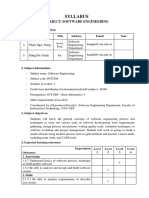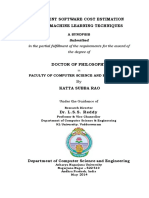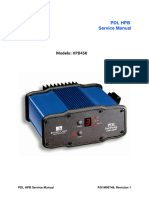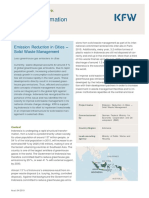SEM Handout
SEM Handout
Uploaded by
Divyanshu TiwariCopyright:
Available Formats
SEM Handout
SEM Handout
Uploaded by
Divyanshu TiwariCopyright
Available Formats
Share this document
Did you find this document useful?
Is this content inappropriate?
Copyright:
Available Formats
SEM Handout
SEM Handout
Uploaded by
Divyanshu TiwariCopyright:
Available Formats
BIRLA INSTITUTE OF TECHNOLOGY AND SCIENCE, Pilani
Pilani Campus
AUGS/ AGSR Division
FIRST SEMESTER 2021-2022
COURSE HANDOUT
Date: 20.08.2021
In addition to part I (General Handout for all courses appended to the time table) this portion gives further
specific details regarding the course.
Course No : SS G562
Course Title : SOFTWARE ENGINEERING AND MANAGEMENT
Instructor-In-Charge : Tanmaya Mahapatra (Email: tanmaya.mahapatra@pilani.bits-pilani.ac.in)
Course Website : nalanda.bits-pilani.ac.in (The On-Campus Learning Management System)
1. Course Description
Software engineering is a discipline that allows us to apply engineering and computer science concepts in the
development and maintenance of reliable, usable, and dependable software. There are several areas to focus
on within software engineering, such as requirement specification, design, development, testing, maintenance
and project management. Software development outside of the classroom is a very complex process, mostly
because real-world software is much larger and more complex. The purpose of this course is to present
software engineering as a body of knowledge. The course is designed to present software engineering
concepts and principles in parallel with the software development life cycle.
2. Scope and Objectives of Course
This course provides an ability to identify, formulate, and solve complex engineering problems by applying
principles of engineering, science, and mathematics. This also develops an ability to function effectively on a
team whose members together provide leadership, create a collaborative and inclusive environment, establish
goals, plan tasks, and meet objectives. In addition, this course also facilitates with an ability to develop and
conduct appropriate experimentation, analyze and interpret data, and use engineering judgment to draw
conclusions
3. Text Books
Sommerville I, Software Engineering, Pearson Education, 10th Edition, 2017.
4. Reference Books
Pressman, R.S., Software Engineering: A Practitioner's Approach, 7th (Alternate) Edition, McGraw Hill
International Edition, 2010
Please Do Not Print Unless Necessary
BIRLA INSTITUTE OF TECHNOLOGY AND SCIENCE, Pilani
Pilani Campus
AUGS/ AGSR Division
Jalote, P., An Integrated Approach to Software Engineering, Narosa, 2nd Ed., 1998
Schach, S., Software Engineering, TMH, 7th Ed., 2007.
Behforooz, A. & F.J. Hudson, Software Engineering Fundamentals, OUP, 2006
Ahmed A, “Foundations of Software Engineering", CRC Press, 2016.
Additional Readings as assigned and/or made available online by the I/C.
5. Course Modules
Module Module Learning Objective
#
1 Background and To understand the basic concepts and motivation about this course.
Introduction (2
Lecture)
2 Software To understand numerous lifecycle models utilized for maintaining and
Development developing the software. To understand how to select an appropriate
Lifecycle Models lifecycle model for a particular project.
(3 lectures)
3 Requirements To understand the customer requirements and to systematically
Analysis and organize the requirements into a document using Software Requirement
Specifications (6 Specification and Formal Notations.
lectures)
4 Software Project To understand how to enable a group of developers to work effectively
Management (10 towards the successful completion of a project.
lectures)
5 Software Design To understand the activities carried out during the design phase and
(5 lectures) how to transform the generated specifications into the design document.
To understand how to decompose a problem into different modules and
how to identify the relationships and the associated interfaces among
several modules.
6 Software To understand how to quantitatively measure the reliability of a
Reliability (2 software product and how to predict when a given level of reliability
Lectures) will be achieved.
7 Software Coding To understand that how to transform the design of a system into some
and Testing (14 code in high-level language and then to unit test this code. To
lectures) understand how to detect the bugs in a program using different testing
techniques.
Please Do Not Print Unless Necessary
BIRLA INSTITUTE OF TECHNOLOGY AND SCIENCE, Pilani
Pilani Campus
AUGS/ AGSR Division
6. Lecture Schedule
Lecture Modules Topics
No.
1-2 Background, Evolution of an Art into an Engineering Discipline, What is
Motivation and Software Engineering, Exploratory Style of Software
Introduction Development, Principles of Software Engineering to Overcome
Human Cognitive Limitations, Rise of Software Engineering
3-5 Software Lifecycle Introduction, Waterfall Model and its Variants: Classical
Models Waterfall Model, Iterative Waterfall Model, V-Model,
Prototyping Model, Incremental Development Model and
Evolutionary Model. Rapid Application Development (RAD)
Model, Spiral Model, Agile Development Models, Selection of
Appropriate Lifecycle model for a project
6-11 Requirement Requirement Gathering and Analysis, Software Requirement
Analysis and Specification (SRS), Techniques for Handling Complex Logic
Specifications through Semi-Formal techniques: Decision Trees and Tables,
Formal System Specifications using Algebraic Specifications
and Axiomatic Specifications.
12-21 Software Project Complexities of Software Project Management, Techniques for
Management Project Size Estimation: Lines of Code (LOC) and Function
Techniques Point (FP). Project Estimation Techniques: Empirical Estimation
Techniques, Heuristic Estimation Techniques: COCOMO,
Complete COCOMO and COCOMO 2, Analytical Technique:
Halstead’s Software Science. Staffing level Estimation, Project
Scheduling: Work Breakdown Structure (WBS), Activity
Networks, Critical Path Method, PERT Chart, Earned Value
Analysis, Project Crashing
22-26 Software Design Outcome of Design Process, Classification of Design
Methodologies, Characteristics of a Good Design, Modularity of
Design, Cohesion and Coupling, Classification of Cohesion and
Coupling. Function-Oriented Design and Object-Oriented
Design
27 - 28 Software Software Reliability: Hardware versus Software reliability,
Reliability Reliability Metrics, Reliability Growth Models: Jelinski and
Moranda Model, Littlewood and Verall’s Model, Basic
Execution Model and Logarithmic Poisson Execution Model
29-43 Software Coding Software Coding: Errors, faults and Failures, Techniques for
and Testing Reducing the Bugs in program. Software Testing: Verification
and validation, Pesticide Effect in testing, Test Cases, Minimal
Test Suite, Unit Testing, Black-box Testing Strategies:
Equivalence Class Partitioning Testing and its Derivatives,
Please Do Not Print Unless Necessary
BIRLA INSTITUTE OF TECHNOLOGY AND SCIENCE, Pilani
Pilani Campus
AUGS/ AGSR Division
Special Value Testing Strategies: Boundary Value Analysis,
Robustness Testing, Combinatorial Testing Strategies: Decision
Table-Based testing and Pair-Wise Testing. White-Box Testing
Strategies: Strong testing, Weaker testing, Complimentary
testing, Coverage-Based Testing Strategies: Statement Coverage,
Branch Coverage, Path Coverage, Condition Coverage, MC/DC
Coverage, Data flow-based Testing Strategies
The reference to these topics will be the prescribed text book and the class notes of students.
7. Evaluation Scheme:
Component Mode Duration Date Weightage
Mid-Semester Exam Closed Book 90 Minutes As per AUGSD Guidelines 35%
Team Project/Assignment Take Home and Open - TBA 25%
Book
Comprehensive Exam Partially Open Book 120 Minutes As per AUGSD Guidelines 40%
Team Project
A complete project is to be done by a team of students in two Stages using the practices of Software
Engineering covered in the regular lectures. In Stage I, the project will aim to provide you hands-on
experience with different aspects of Software Engineering including designing of informal specifications,
semi-formal specifications and formal specifications using SRS document, decision table and algebraic
specifications. Stage II include designing of DFD modelling, Activity Network, Work Breakdown Structure
and PERT charts. In addition, you will also have to design the test cases corresponding to the working
prototype of your project. Overall, you will be working on these aspects of an assigned project to get a feel of
the real-life software development process.
Evaluation will be done continuously, on the basis of the quality of work products delivered according to the
project plan and schedule, as well as process compliance. Grades assigned to individual students are
determined using periodic presentations, design and other documents, teamwork, quality of the prototype and
the product, and technological innovation.
8. Consultation Hour
Students can discuss their doubts and other queries related to the course in the contact hours on Google Meet
once/twice in a week.
9. Notices: Necessary notices, course announcements, uploading of marks of each component will be done
on BITS-Nalanda or on Google Classroom. You are requested to check the course website periodically.
10. Make-up Policy
• Mid-Sem Exam has one make-up. This means, that a student can abstain herself/himself (on valid
reasons) in this Test. This make up would be conducted immediately after regular mid-sem exam and
Please Do Not Print Unless Necessary
BIRLA INSTITUTE OF TECHNOLOGY AND SCIENCE, Pilani
Pilani Campus
AUGS/ AGSR Division
would include complete syllabus. Of course, the student would apply for the make up in advance with
documentary proof.
• Only on producing documentary proof of possible absence, which proves that student would be
physically unable to appear for the test/exam, the decision of granting the make-up will be taken.
• Prior Permission of AUGSD is required to get make-up for the comprehensive exam.
Instructor-in-Charge
SS G562
Please Do Not Print Unless Necessary
You might also like
- DOLE ChecklistDocument3 pagesDOLE ChecklistJohn Menguito100% (1)
- Unit 9 Assignment (Spring 2021)Document5 pagesUnit 9 Assignment (Spring 2021)Ultra ChannelNo ratings yet
- SE - Lesson PlanDocument5 pagesSE - Lesson Planabhaymallik94No ratings yet
- Software Engineering Lab Manual For GUDocument47 pagesSoftware Engineering Lab Manual For GUABCNo ratings yet
- Notes Unit 1Document17 pagesNotes Unit 1Viyan SinghNo ratings yet
- Se SyllabusDocument2 pagesSe SyllabusSubh AryanNo ratings yet
- 1 21cst601-SepmDocument3 pages1 21cst601-Sepmvarshithaga3052003No ratings yet
- 01.MSPracticumFall2021CourseDescription EngrAbdulRahmanDocument3 pages01.MSPracticumFall2021CourseDescription EngrAbdulRahmanMahmoodAbdul-RahmanNo ratings yet
- Software EngineeringDocument2 pagesSoftware Engineeringanushkaanand2021No ratings yet
- CS1504 - Software Engg.Document2 pagesCS1504 - Software Engg.krishna kumarNo ratings yet
- Software EngineeringDocument2 pagesSoftware Engineeringcoastudies100% (1)
- 1 Outline SE F2021Document6 pages1 Outline SE F2021Abdullah JuttNo ratings yet
- Software Engineering (Syllabus)Document3 pagesSoftware Engineering (Syllabus)YouTube all typeNo ratings yet
- CSE3001 Software-Engineering ETH 1 AC39 PDFDocument8 pagesCSE3001 Software-Engineering ETH 1 AC39 PDFAnonymous TpYSenLO8aNo ratings yet
- Is3139 CisDocument2 pagesIs3139 CisFernando DarmawanNo ratings yet
- Swe CifDocument3 pagesSwe CifHAQNo ratings yet
- Course Description Form: Barrett Hodgson University The Salim Habib CampusDocument10 pagesCourse Description Form: Barrett Hodgson University The Salim Habib CampusSheeraz ArifNo ratings yet
- PPSyllabuspdf 2024 02 03 11 39 26Document4 pagesPPSyllabuspdf 2024 02 03 11 39 26mnatsu0432No ratings yet
- Sem2 4Document7 pagesSem2 4Pavan Kumar SNo ratings yet
- Se SyllabusDocument2 pagesSe SyllabusDr G V V NagarajuNo ratings yet
- Software EngineeringDocument3 pagesSoftware EngineeringImtiyaz BashaNo ratings yet
- CS 349 Software Engineering Syllabus VER 1.0Document4 pagesCS 349 Software Engineering Syllabus VER 1.0YASH GAIKWADNo ratings yet
- Faculty of Engineering & TechnologyDocument4 pagesFaculty of Engineering & TechnologyUmaNo ratings yet
- Gujarat Technological University: Computer Engineering (07) and Information Technology (16) Subject Code: B.E. 6 SemesterDocument21 pagesGujarat Technological University: Computer Engineering (07) and Information Technology (16) Subject Code: B.E. 6 Semesterbalj balhNo ratings yet
- SE LAB Contents PDFDocument6 pagesSE LAB Contents PDFSalman KhizerNo ratings yet
- Unit 1 Introduction To Software EngineeringDocument25 pagesUnit 1 Introduction To Software EngineeringRavi RavalNo ratings yet
- Gujarat Technological University: Software Engineering Semester VDocument7 pagesGujarat Technological University: Software Engineering Semester VSejal YadavNo ratings yet
- UT Dallas Syllabus For cs3354.501 05f Taught by Hieu Vu (hdv013000)Document3 pagesUT Dallas Syllabus For cs3354.501 05f Taught by Hieu Vu (hdv013000)UT Dallas Provost's Technology GroupNo ratings yet
- BCAMA-501 SLM 724Document222 pagesBCAMA-501 SLM 724Anish ShaikhNo ratings yet
- Syllabus: Subject: Software EngineeringDocument4 pagesSyllabus: Subject: Software EngineeringTuyên Kiều VănNo ratings yet
- Program(s) B Tech Academic Session, Semester Subject Name Subject CodeDocument4 pagesProgram(s) B Tech Academic Session, Semester Subject Name Subject CodeAnkur TiwariNo ratings yet
- Efficient Software Cost Estimation Using Machine Learning TechniquesDocument20 pagesEfficient Software Cost Estimation Using Machine Learning Techniquessheela uppalagallaNo ratings yet
- SecompDocument19 pagesSecomparun.garhewal2015No ratings yet
- TBC 305 Software EngineeringDocument2 pagesTBC 305 Software EngineeringViyan SinghNo ratings yet
- SRE Course Outline F22Document4 pagesSRE Course Outline F22M Abubakar GhummanNo ratings yet
- Semester: IV Subject Name: Software Engineering Subject Code: 09CE0402Document8 pagesSemester: IV Subject Name: Software Engineering Subject Code: 09CE0402aNo ratings yet
- CS-321 Software Engineering - UpdateDocument6 pagesCS-321 Software Engineering - UpdateMirza AbubakrNo ratings yet
- TBC 403 Project Management and Quality AssuranceDocument2 pagesTBC 403 Project Management and Quality AssuranceYashasvi ranaNo ratings yet
- NewSyllabus 10120148176317Document3 pagesNewSyllabus 10120148176317Pritam KumarNo ratings yet
- New SyllabusDocument11 pagesNew SyllabusKhush KukrejaNo ratings yet
- 19287.SE Theory CSL3307 ProposalDocument4 pages19287.SE Theory CSL3307 ProposalPrince PathriaNo ratings yet
- SPM Syllabus 2024Document4 pagesSPM Syllabus 2024SIT 147- Mhatre HardikNo ratings yet
- System Analysis and DesignDocument7 pagesSystem Analysis and DesignAlik GhoshNo ratings yet
- Software Testing Methodologies - NewDocument120 pagesSoftware Testing Methodologies - Newkarthikaravelli04No ratings yet
- Software Notes2018Document159 pagesSoftware Notes2018AshleyNo ratings yet
- 2-QUESTION PAPER DR K UMA Question Bank CS3001 SOFTWARE ENGG-converted1Document71 pages2-QUESTION PAPER DR K UMA Question Bank CS3001 SOFTWARE ENGG-converted1MAHENDRANo ratings yet
- Lab Manual of Software Engineering CompleteDocument56 pagesLab Manual of Software Engineering CompleteM Anas MeuvaNo ratings yet
- 01.MSPracticumIISpring2022CourseDescription EngrAbdulRahman v2Document3 pages01.MSPracticumIISpring2022CourseDescription EngrAbdulRahman v2MahmoodAbdul-RahmanNo ratings yet
- 6th Sem SyllabusDocument15 pages6th Sem SyllabusSwati KhanduriNo ratings yet
- 6.39-Mu MSC Datascience Semiii Revised Syallbus 20211Document29 pages6.39-Mu MSC Datascience Semiii Revised Syallbus 20211shaikhaaqifNo ratings yet
- Report of SEDocument52 pagesReport of SERohitNo ratings yet
- Softwsre Engineering Lesson Plan For Teaching StaffDocument1 pageSoftwsre Engineering Lesson Plan For Teaching StaffRajesh KannaNo ratings yet
- Final IM COMP 20324 SOFTWARE DESIGNDocument91 pagesFinal IM COMP 20324 SOFTWARE DESIGNCharl CuaNo ratings yet
- Course Outline - Software Engineering 1 (BSCS-Fall17)Document4 pagesCourse Outline - Software Engineering 1 (BSCS-Fall17)hamzaNo ratings yet
- Us05cbca03 - Software EngineeringDocument2 pagesUs05cbca03 - Software EngineeringRadha IshuNo ratings yet
- 7 Computer Science Engineering SyllabusDocument5 pages7 Computer Science Engineering Syllabusshubhamkr91234No ratings yet
- Ics 2302 SW Eng I Course Outline-1Document2 pagesIcs 2302 SW Eng I Course Outline-190tNo ratings yet
- Se Monograph CST-220 PDFDocument119 pagesSe Monograph CST-220 PDFDe Vansh VermaNo ratings yet
- Fundamentals of Software Engineering: Designed to provide an insight into the software engineering conceptsFrom EverandFundamentals of Software Engineering: Designed to provide an insight into the software engineering conceptsNo ratings yet
- Software Engineering New Approach (Traditional and Agile Methodologies)From EverandSoftware Engineering New Approach (Traditional and Agile Methodologies)No ratings yet
- Software Testing Interview Questions You'll Most Likely Be AskedFrom EverandSoftware Testing Interview Questions You'll Most Likely Be AskedNo ratings yet
- Sem Compre HandoutDocument14 pagesSem Compre HandoutDivyanshu TiwariNo ratings yet
- SEM Comprehensive Examination HandoutDocument12 pagesSEM Comprehensive Examination HandoutDivyanshu TiwariNo ratings yet
- Smart Artificial Intelligence Based Online Proctoring SystemDocument5 pagesSmart Artificial Intelligence Based Online Proctoring SystemDivyanshu TiwariNo ratings yet
- Research On The Trusted Online Examination SystemsDocument10 pagesResearch On The Trusted Online Examination SystemsDivyanshu TiwariNo ratings yet
- 10.1 Reverse Each Word EditorialDocument4 pages10.1 Reverse Each Word EditorialDivyanshu TiwariNo ratings yet
- Lecture 1 - Getting To Know ScalabilityDocument49 pagesLecture 1 - Getting To Know ScalabilityDivyanshu TiwariNo ratings yet
- Aic Lec 01 Introduction v01Document46 pagesAic Lec 01 Introduction v01Ahmed Al-SayedNo ratings yet
- CAE Writing Part 1: Formal Essay: Task TypeDocument6 pagesCAE Writing Part 1: Formal Essay: Task TypeToni DuranNo ratings yet
- Sustainable Tourism ManagementDocument22 pagesSustainable Tourism ManagementDaisyNo ratings yet
- IELTS Reading SampleDocument10 pagesIELTS Reading SampleCristine WastonNo ratings yet
- Week 7 Inductive Reasoning: Central Bicol State University of AgricultureDocument17 pagesWeek 7 Inductive Reasoning: Central Bicol State University of AgricultureColleen Castuera100% (1)
- Manual Service Pacific CrestDocument126 pagesManual Service Pacific CrestsouzadearnaldoNo ratings yet
- Topic 1. Parents Are Too Permissive With Their Children NowadaysDocument26 pagesTopic 1. Parents Are Too Permissive With Their Children NowadaysBùi Thanh Ngọc BíchNo ratings yet
- Scott Labs Handbook 2018Document71 pagesScott Labs Handbook 2018ianerudaNo ratings yet
- A Guide To Depth Studies October 2017 1 of 8Document8 pagesA Guide To Depth Studies October 2017 1 of 8conchoNo ratings yet
- (AHWT) : The DifferenceDocument2 pages(AHWT) : The DifferenceRyan Bacarro BagayanNo ratings yet
- Detection and Monitoring of Underground Coal Mine Gases at Lakhra Coal Mines, PakistanDocument2 pagesDetection and Monitoring of Underground Coal Mine Gases at Lakhra Coal Mines, PakistanAhsan AliNo ratings yet
- Writing Activities in Techcnical WritingDocument11 pagesWriting Activities in Techcnical WritingCruzel Mata CortesNo ratings yet
- Lesson 12Document20 pagesLesson 12shrekpoop8No ratings yet
- Unit 2 - Activity 2 - Revisión Del IntentoDocument6 pagesUnit 2 - Activity 2 - Revisión Del IntentoRENZO JOVANI PARDO URBANONo ratings yet
- Physics 41 Calorimetry: Determination of Specific Heat Capacity of CopperDocument2 pagesPhysics 41 Calorimetry: Determination of Specific Heat Capacity of CopperAmeva Ameve Sinangote CañosoNo ratings yet
- Homework 5 J23Document5 pagesHomework 5 J23mauoshaNo ratings yet
- KFW - Emission Reduction in CitiesDocument2 pagesKFW - Emission Reduction in CitiesSamuel HutabaratNo ratings yet
- Jurnal SemenDocument8 pagesJurnal SemenDross AlssNo ratings yet
- OSM ConsolEx 4A04 Ans eDocument3 pagesOSM ConsolEx 4A04 Ans emikeeeerrNo ratings yet
- Review All Maths Year 8Document8 pagesReview All Maths Year 8ra niaNo ratings yet
- Spray Rating TesterDocument7 pagesSpray Rating TesterTawfiq Hossain KhanNo ratings yet
- Narrative Report On Kamustahan For Grade 8Document2 pagesNarrative Report On Kamustahan For Grade 8ROSIEL MANDRIQUENo ratings yet
- Example of A Thesis Statement For Persuasive EssaysDocument5 pagesExample of A Thesis Statement For Persuasive Essaysjennifermarietopeka100% (2)
- Water MGT in HillDocument15 pagesWater MGT in HillIrfan HyderNo ratings yet
- Writing Sample 1Document3 pagesWriting Sample 1api-490551088No ratings yet
- Project Proposal For INSET On M365 Adoption Science Dept Libertad NHSDocument4 pagesProject Proposal For INSET On M365 Adoption Science Dept Libertad NHSRosemary Golapo Ipanag Madelo100% (1)
- For Trends - Week2Document25 pagesFor Trends - Week2jayroldparcedeNo ratings yet
- Public Elementary Teachers' Motivation and Pedagogical Competence in Teaching Non-Readers A Correlational StudyDocument8 pagesPublic Elementary Teachers' Motivation and Pedagogical Competence in Teaching Non-Readers A Correlational StudyJournal of Interdisciplinary PerspectivesNo ratings yet
- Chapter 1 Coulombs Law and Electric FieldsDocument63 pagesChapter 1 Coulombs Law and Electric FieldsWoke LossNo ratings yet































































































